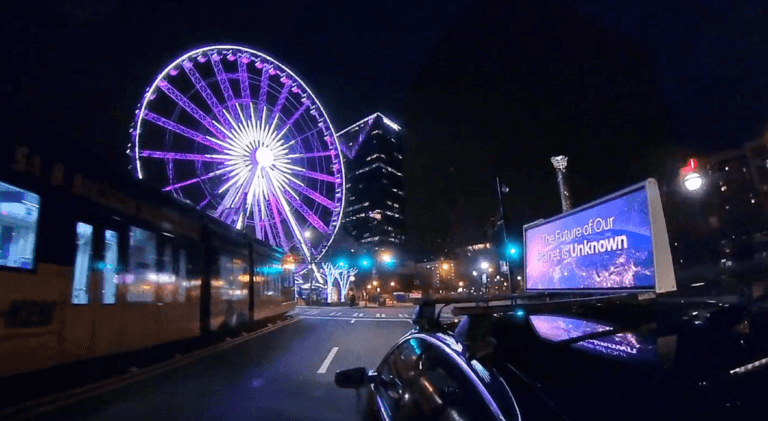
Advertising on taxi tops have been around for quite some time now. The idea originated in the USA in 1976 and has been adopted by many cities around the world ever since. The original concept of taxi top advertisements was simple and straightforward – a vehicle that is always near busy streets and buzzing areas presents an excellent opportunity for advertisements to reach the masses at a fraction of the cost of static billboards. Taxi advertising has the ability to reach audiences such as locals, businesses, and tourists that are located on routes to and from airports, hotels, convention centers, sporting events, shopping centers, and restaurants. According to a report by Nielson on Out-Of-Home (OOH) advertising in 2016, 39% of those surveyed noticed ads on taxis or other vehicles in the past month and 21% noticed one in the past week. With Uber and Lyft disrupting the taxi industry, it’s no surprise that they have also launched car-top ads to keep up with the ever-changing advertising trends while staying competitive.
Taxi Ads
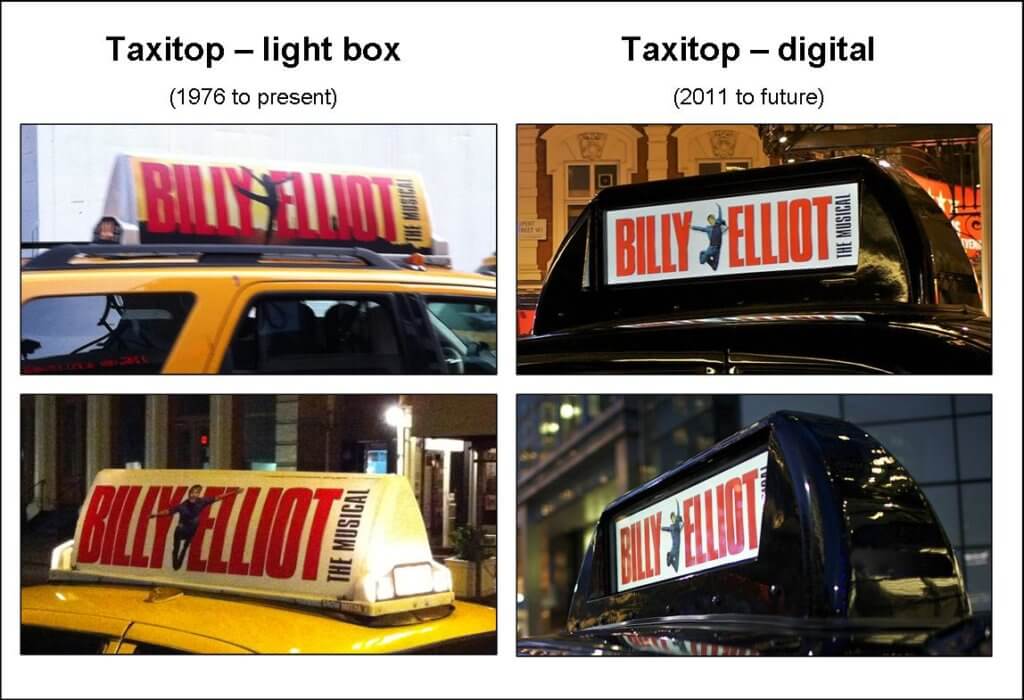
Over the years, taxi ads have had a trademark look – displaying a triangular box that pops out from the roof of the vehicle. Nowadays, taxi ads have come a long way in terms of design and engineering. The new design is metal, LED lit, recyclable, and has a shiny finish, making the images on ads much more visually appealing. The roof panels are double-sided and backlit to attract consumers from opposing angles. The ads placed on the roof of the cabs can be spotted from a distance and provide an eye-level point of view advantage over elevated billboards. Cab advertisements can attract consumers at mass volumes, allowing brands to literally drive their message all over town.
Taxi Ad Trends
Taxi ads can encounter problems due to the limited space and restricted size of the ad box. For this reason, the messages must be bold, short, and straight to the point so that consumers are able to absorb the information at a glance. Digital out-of-home advertisements help solve this problem by illuminating screens for better visibility and transmitting more content in a short period of time – such as video screen advertising. The Outdoor Taxi Digital Screen is now one of the fastest growing markets in many parts of the world, as digital LCD screens are replacing the traditional taxi-tops and the Digital Out-Of-Home (DOOH) market is predicted to rise to 38.3% by 2023. With approximately 2 million registered taxis around the world, taxis and other transportation vehicles are becoming a substantial platform for the DOOH market. Another solution and emerging trend is fully-wrapped taxis and vehicles that use the same techniques as fully-wrapped buses.
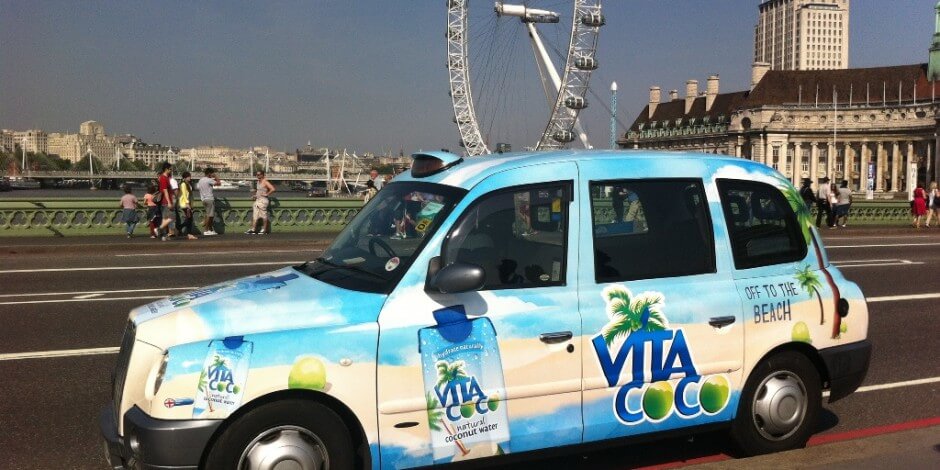
London Taxi Advertising and Vita Coco, a healthy coconut water brand, launched a campaign where 50 vehicles were fully wrapped in the branding message with the aim to reach their target market – health-conscious consumers. The campaign ran for 12 months, proving the inexpensive advantage of vehicle advertising that enables brands to hold a campaign for a long period of time compared to traditional OOH. The campaign gained massive exposure in the city of London with their fully-wrapped blue vehicles that offered an unavoidable presence for Vita Coco amongst the crowd.
Uber and Lyft Enter the OOH Market
A 2018 survey of Canadian adults found a preference for traditional taxis over Uber has a direct relation with the increase of age. 55% of respondents aged over 65 preferred taxis, while only 14% preferred Uber, and the remainder undecided. 49% of respondents aged between 18 and 24 preferred Uber, compared to 23% who preferred taxis. Younger adults are more familiar with ridesharing services like Uber as opposed to the older generation who prefer a means of transportation they have grown accustomed to. That is why Uber targets its services towards millennials and gen Z and has been successful in doing so. However, the Industry has been facing increasing pressure to turn profitable as they have been enduring financial declines where Uber reported a net loss of $8.5 billion in the fiscal year 2019 and Lyft reported a net loss of $0.26 billion in the same period. For this reason, entering the OOH advertising industry to generate revenues seemed to be a viable opportunity to seize. As of April 2020, Uber launched car-top digital billboards and began targeting drivers, passengers, and bypassers. The ride-sharing company has partnered with ad-tech company, Adomni, to create Uber OOH and launched digital screens for drivers. It is now available in Atlanta, Dallas, and Phoenix, with a total of 1,750 vehicles equipped with digital screens – soon to be in Chicago and Los Angeles. Even though independent contractors driving with Uber could previously install ad displays on their vehicles from third-party operators, Uber has now offered an ad platform of its own. Uber has begun to collaborate with Adomni, a digital signage technology company that manages and sells ads on digital signage and mobile devices. Uber sells the ad space by location and time of day with the units featuring two-sided, internet-connected screens on participating Uber drivers’ vehicles. Adomni will also sync car ads with its digital billboards to incentivize brands.
As mentioned above, the outdoor taxi digital screen industry is booming, which in effect, is likely to spawn a large amount of competitors looking to share the success. Lyft has also been making its move into OOH advertising and has recently acquired Halo Cars in February 2020, a Philadelphia-based startup that offers car-topping ad screens. Halo was founded in 2018 and is operating in New York and Chicago. By installing smart LED screens on the roof of vehicles that present geo-targeted video ads, they are offering extra income per month as their incentive for drivers to install Halo. Another competing force to mention is Firefly, a mobility based advertising and data platform that is promising Uber and Lyft drivers more income in exchange for mounting digital screens on their cars.
Uber Eats
Uber Eats, a division of Uber, has been a success since its launch in August 2014. The app allows users to order food for delivery from their favorite local restaurants that are in partnership with them. Due to the pandemic and lockdowns, food delivery services have gained traction in recent months. Uber Eats has experienced a significant growth since March 2020 and has reported a 30% increase in orders. The high demand for delivery services have created potential prospects for Uber Eats, such as grocery-deliveries. What can this mean for their car-top advertising network? Although the market in which Uber has added their OOH feature is relatively minor, their delivery service through Uber Eats is increasing the amount of vehicles being driven and can be used as an opportunity to gain ad exposure in neighborhoods that aren’t easily accessible through traditional OOH billboards.
Uber’s Location- Targeted Ads
Location targeting has become a vital factor in advertising to a specific demographic. Uber promises to mobilize brands that will travel thousands of miles delivering millions of impressions in a time-span of a month. Using geo-target advertising, they are able to precisely target consumers by their location and time of day. The company offers “performance reports” that measure the success of the ad campaign based on the impressions generated. Additionally, their partners provide programmatically connected DOOH to the cartop ads, displaying the same advertisement simultaneously.
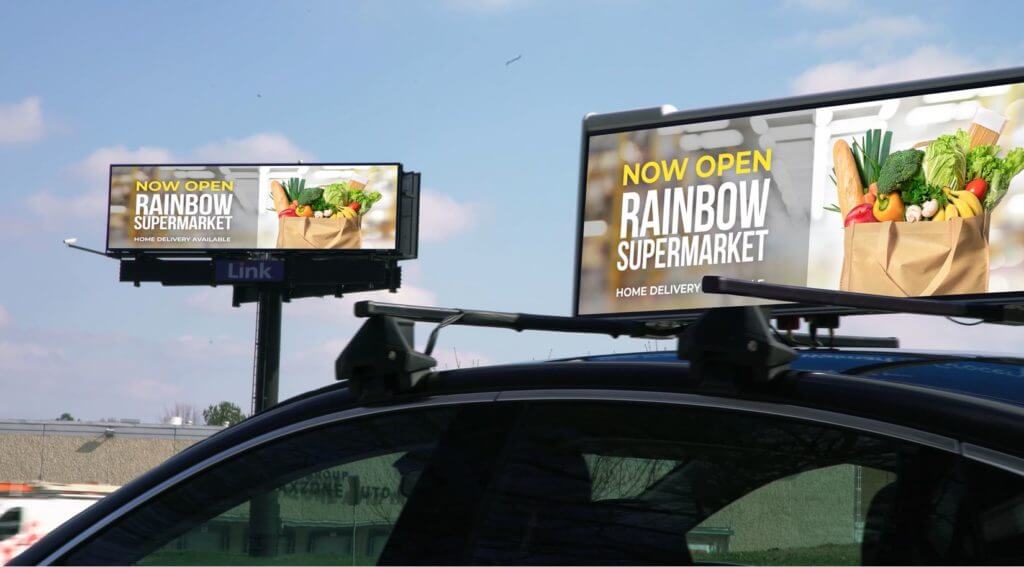
Uber is not the only one who has adopted location-targeted ads on cars; taxis have partnered with companies who provide this service to attract brands to use OOH advertising with cost-efficiency in mind. Below are a few examples of companies who collaborate with brands to provide geo-targeted ads to the target audience required.
Geo-Targeted Ads on Taxis
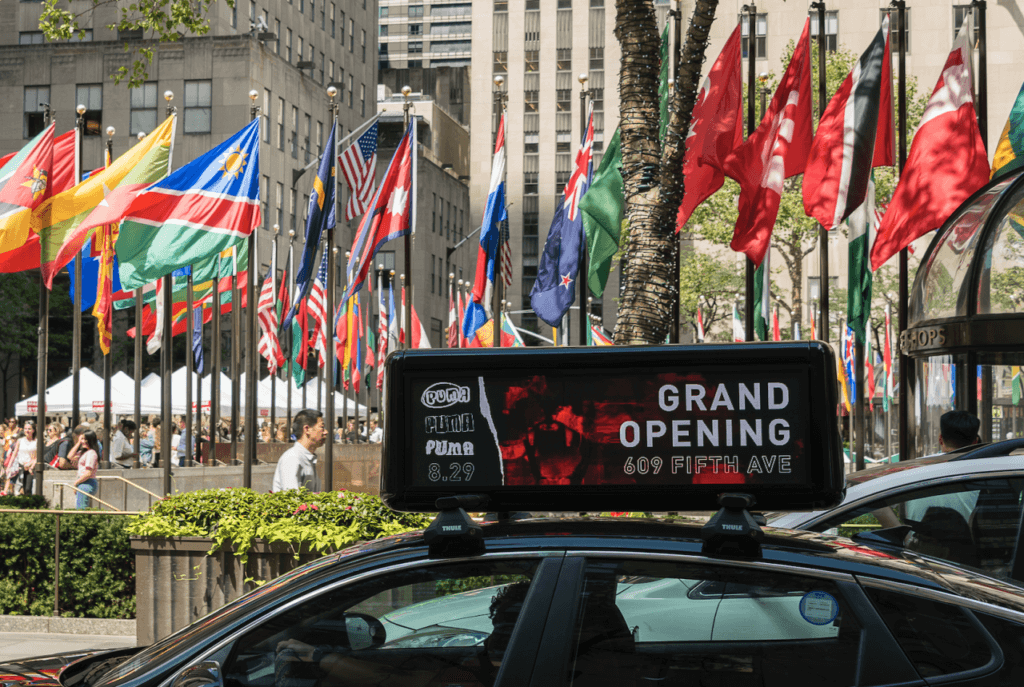
Puma, a leading footwear brand, launched a geo targeted OOH campaign that showcased ad screens on taxi tops and ride-share vehicles. The campaign was used to spread the word about the grand opening of the brand’s flagship store on Fifth Avenue in New York City. The ad was created in partnership with Havas Media Group and Whisk Agency using the vehicle-based screens of Firefly’s network. The ads were displayed when the taxis drove by airports and tourist attractions to target consumers across different locations and times of day in order to promote the new Puma store address.
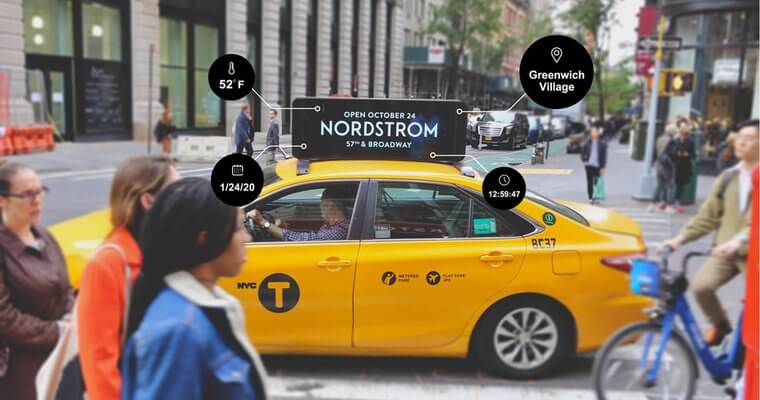
Curb Taxi Media, a taxi advertiser, launched a network of programmatic smart taxi tops in New York City earlier this year, where advertisers used DOOH campaign ads through the Vistar platform. Curb Taxi provided more than 1,100 LCD displays on Vistar that used geotargeting, really simple syndication (RSS) data integration that receives information given by a user’s RSS feed to provide the latest updates from websites. They also integrated dayparting, a pay-per-click (PPC) advertising tactic used to schedule ads for certain times of day or certain days of the week, as well as live weather updates. Chris Polos, head of Curb Taxi Media, stated that, “Connecting with on-the-go consumers is a critical part of the marketing funnel. By enabling brands to tap into the benefits of programmatic digital taxi top advertising, we’re providing a unique medium to reach consumers with eye-level messaging and a coverage area far greater than what’s possible with traditional OOH.”
The Bottom Line
With a rise in demand for OOH advertising on top of taxi cabs, many start-up companies are entering the market and providing advertisers with added value using trends such as geo-targeted data to better the chances for a successful campaign, DOOH for better engagement with bypassers, and fully wrapped vehicles that are both cost-efficient and attractive for optimal results. Transportation companies like Uber and Lyft have also decided to penetrate the market by enabling DOOH ads to their cartops. The ads display images and videos that will depend on geolocation and time of day. Moreover, the partnership between Uber and Adomni allows for a synchronized campaign between Uber screens and OOH billboards. With technology and creativity becoming the main indicators for successful brand campaigns, we are sure to see more traditional mediums transform into new and exciting innovations in the years to come.


